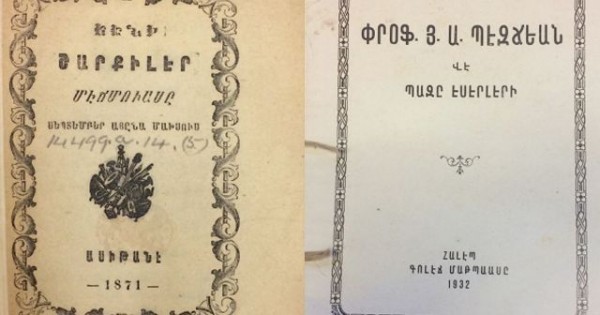
Image credit: British Library
ishtartv.com - scroll.in
In
the Ottoman Empire, Turkish in scripts other than Arabic were commonplace.
For
those who have learnt foreign languages, the presence of a loanword can be both
comforting and surreal. In languages written in non-Roman scripts, a borrowed
word – take computer as an example – greatly eases the task of building
vocabulary; it is far simpler to remember the Japanese konpyutaa than the
Hungarian számítógép.
However,
such loanwords can also be disorienting, triggering memories of one’s mother
tongue while confronting it with the sight of a totally foreign representation.
Now imagine that nearly every word in a text was much the same. This phenomenon
is referred to as allography, and, in the period before standardised
orthographies, state-sponsored schooling and the mass media, it was an
exceptionally common occurrence.
Among
the most famous of cases are the Jewish languages of Yiddish and Ladino, but in
the Ottoman Empire, where secular, state-directed education was not enforced
until the 20th century, Turkish in scripts other than Arabic was a matter of
routine business.
The
two largest allographic communities were the Armenians and the Greeks.
Armeno-Turkish – a rendering of Ottoman Turkish in Armenian letters – gave rise
to a vibrant publishing industry and cultural community. The orthography was
largely phonetic and based upon Western Armenian readings of the letters. It
was in Armeno-Turkish that many French and other Western European works came
into Turkish. This was a situation assisted by the reticence of the Sublime
Porte to authorise Ottoman Turkish printing presses, despite the expansion of
Armenian, Greek and Jewish ones.
Many
volumes printed were religious works, for example BL 14400.c.4, shown above, a copy
of the Old Testament. The growth of an Armenian middle class gradually
permitted the flourishing of secular publication as well, allowing for the
appearance of translations, adaptations and original works. A case in point is
the collection of şarkılar, or folksongs, in Armeno-Turkish shown below, BL
14499.a.14(5).
That
the Armeno-Turkish cultural sphere was a world in its own right is attested to
by an Armeno-Turkish guide to the works of Professor Bezjian published in
Aleppo in 1932, four years after the introduction of a Latin script for
Turkish, and more than a decade and a half after the tragic events of 1915.
Turkish
written in Greek characters also laid the foundation for a vibrant publishing
industry, with a heavy emphasis on religious materials. The language, known as
Karamanlidika in Greek and Karamanlıca in Turkish, was the everyday idiom of
the Turkish-speaking Greek Orthodox Christians of Anatolia. Despite being
ethnically and linguistically Turkish, their religion required them to be
classified as Rum or Greek Orthodox under the Ottoman system.
The
Orthodox clergy controlled education, and a tradition of literacy in Greek
letters, rather than modified Arabic script. Although many of the Library’s
holdings in Karamanlidika are translations of the New Testament – usually
published by British missionaries, for example BL 14400.a.28 below – there are
also a few non-scriptual examples. One is a play based on the story of
Abraham’s sacrifice, a story that is revered by Jews, Christians and Muslims
alike (BL 14469.c.4).
The
final example of allography from the Ottoman Empire is a much less common one,
but no less interesting. It is of the newspaper Leshānā d’umthā, Syriac for Voice
of the Nation (BL 753.k.35). This bi-weekly was produced in Beirut, Lebanon
from 1927 until 1946 and had articles in Syriac, Arabic and Turkish.
Arabic
written in Syriac script is a common occurrence throughout the Christian
Orient, and is referred to as Garshuni. Turkish written in Syriac characters,
however, is far rarer, and represents a unique view into the linguistic,
political and cultural identity of Beirut’s Christian communities decades after
the end of Ottoman sovereignty.
Unlike
Armeno-Turkish, the author of the Ottoman Turkish articles in this periodical
adhered to Ottoman orthography as much as possible, even when it did not
conform to the spoken language. This indicates that the compiler of the
articles was educated in Ottoman Turkish, yet opted to write in Syriac script;
a reminder of just how powerful the visual aspects of language were and are in
the Middle East.
Questions
of script, orthography and language were not limited to the minority
communities. Indeed, perhaps the most vibrant discussions were held about the
majority language itself. Ottoman intellectuals frequently debated script and
grammar reforms in discussions that impinged on issues of identity, power and
connectivity. The edition of the Islamic theological tract, İlm-i Hal, produced
by the Society for the Teaching of a New Script in the second decade of the
20th century, exemplifies this latter push for change (BL ITA.1994.a.128).
One
of only three publications by the Society, it sought to reconcile orthographic
efficiency with tradition by adding vowel characters to the Arabic script, some
of which were based on Old Turkic runes. Like the allographies of the
Armenians, Greeks and Syriac Christians, this attempt would fall victim to the
drive for standardisation and generalisation of the new age of nations ushered
in by the end of the First World War. Today, these publications remain as
memorials to the colourful and pluralistic cultural milieus of the age of
empires.
This
article first appeared on British Library’s Asian and African Studies blog.
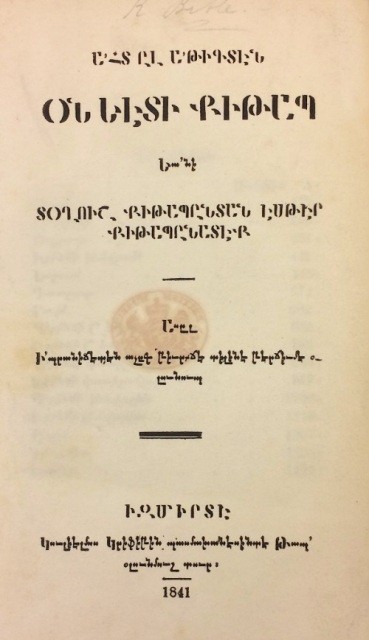
Ahd-i Atikten On Yedi Kitap, yani Doğuş Kitabından Ester Kitabınadek, or The Old Testament from Genesis to the Book of Esther. Izmir: Grifilyan Basmahanesi, 1841 (BL 14400.c.4)
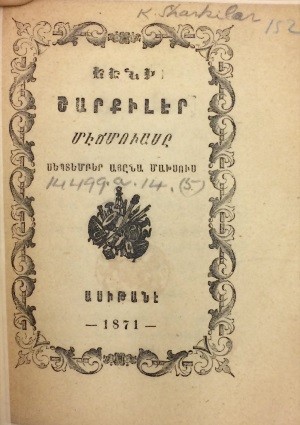
Yeni Şarkiler Mecmuası, or The Journal of New Folk Songs.
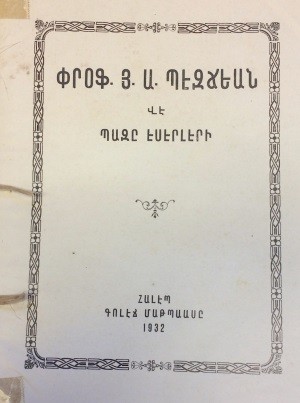
Prof. Y. A. Bezciyan ve Bazi Onun Eserleri, or Prof. Y. A. Bezjian and Some of His Works. Aleppo: Halep Kolej Matbaası, 1932
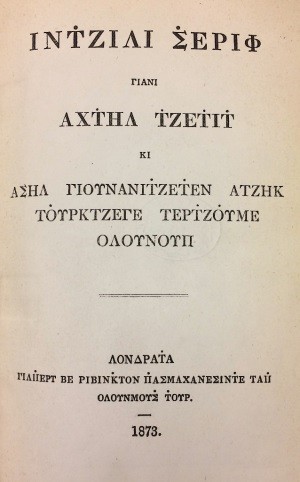
Incili Şerif, yani Ahd-i Cedid, or The Holy Gospel, or the New Testament. London: Rildert and Rivington Publishers, 1873 (BL 14400.a.28)
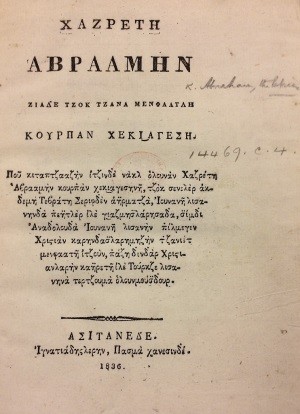
Hazreti Avraamin: Ziyade Cok Cana Menfaatı Kurban Hikayesi, or Saint Abraham: The Sacrifice Story, of Great Use to Many Souls. Istanbul: Ignatious Basmahanesi, 1836 (BL 14469.c.4)
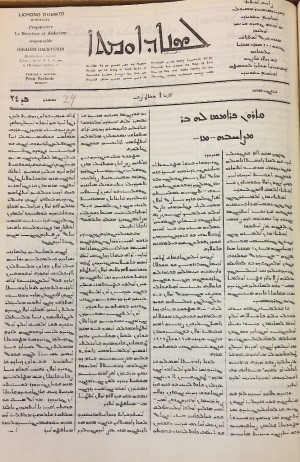
The Syriac-script, trilingual (Syriac-Arabic-Turkish) biweekly Leshono d’Umtho, or Tongue of the Nation. Beirut, 1928 (BL 753.k.35(2))
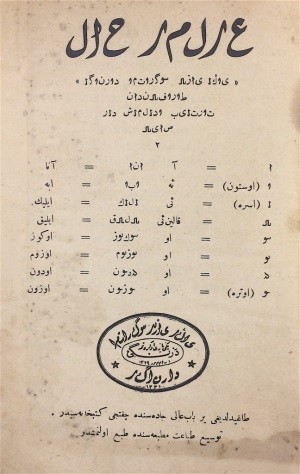
İlm-i Hal, or Catechism. The complete collection of faith-based knowledge for Muslims, printed in a modified Perso-Arabic script. Istanbul: Tevsi-i Tabaat Matbaası, [1910?](BL ITA.1994.a.128)
|